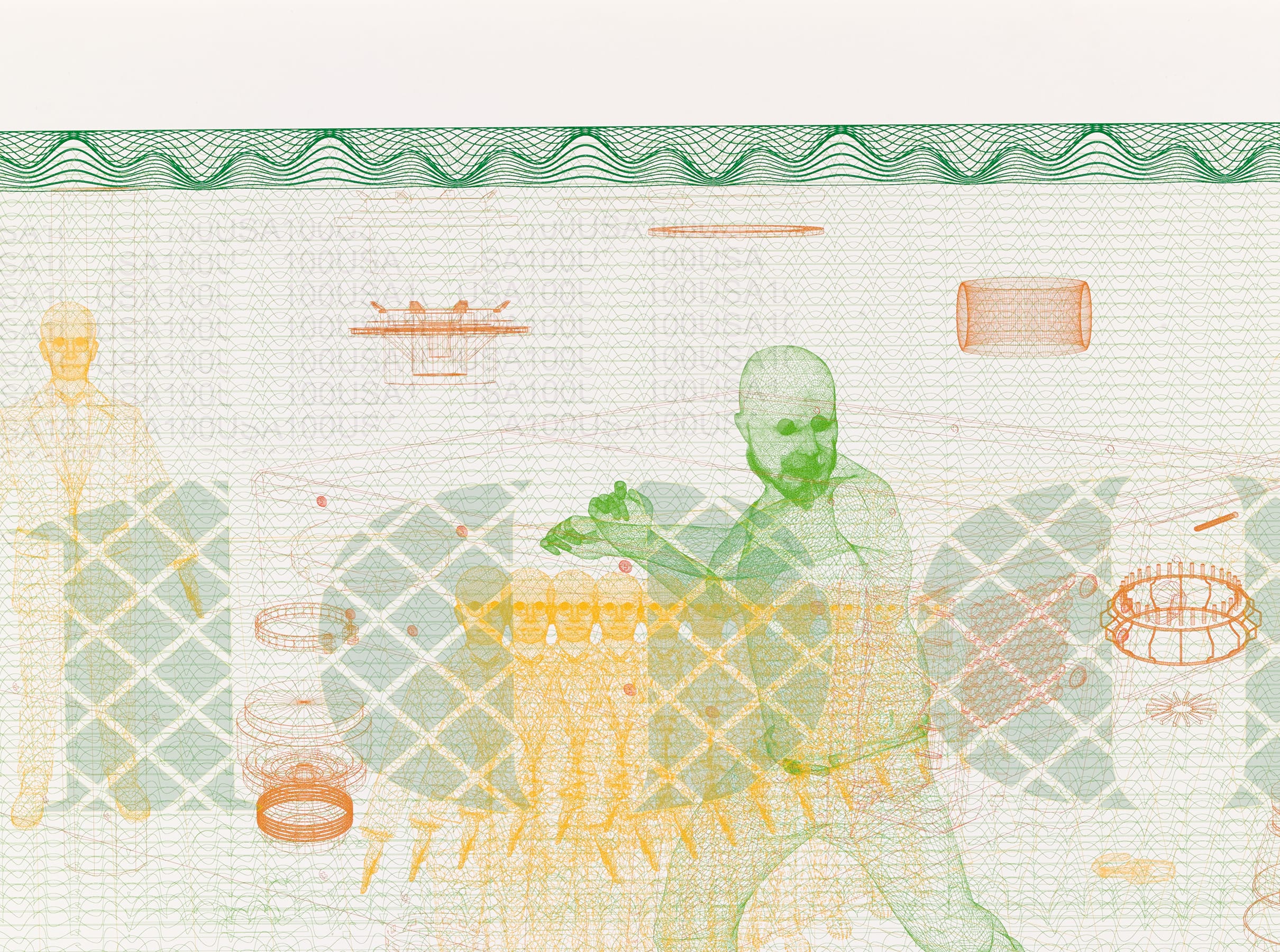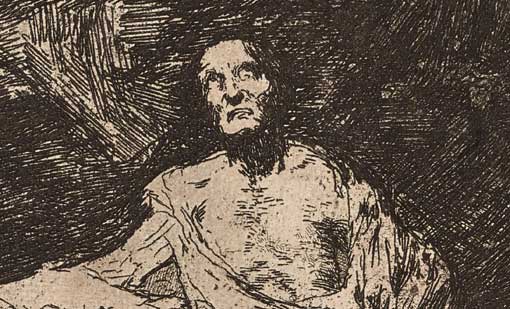
Disasters of War. Goya's early 19th century anti-war statement remains valid today
Between 1810 and 1814, Francisco de Goya produced a series of 80 prints known as Disasters of War. José Manuel Matilla, Head of Conservation of Drawings and Prints at the Museo Nacional del Prado![]() , describes them as "the greatest expression ever produced by an artist of the irrationality of violence and its dire consequences for humanity".
, describes them as "the greatest expression ever produced by an artist of the irrationality of violence and its dire consequences for humanity".
Sadly, current events make it clear that Goya's critique of war remains entirely relevant. Indeed, social media, newspaper articles and TV programmes have been showing engravings from this series, which the Banco de España Collection acquired in 2018, to illustrate the desolation and fear caused by the war in Ukraine. They have also been used for the same purpose in many earlier conflicts. Matilla writes that in these prints and in his paintings based on the events of May 2nd and 3rd 1808, Goya created a set of universally iconic images on the theme of violence, highlighting the "essence of evil that it entails" and giving us pictures "at which we cannot remain indifferent, because the very sight of them is like a fist punching into our consciences".
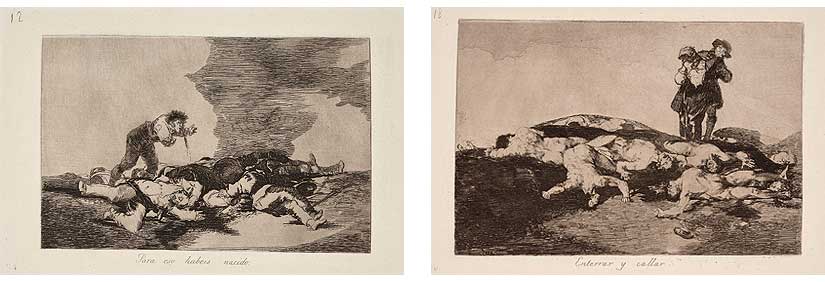 Francisco de Goya: This is what you were born for | Bury them and Keep Quiet
Francisco de Goya: This is what you were born for | Bury them and Keep Quiet
The series originated when General José de Palafox called on Goya and other artists to bear witness to the Siege of Zaragoza![]() (1808-1809), one of the most iconic episodes of the Peninsular War. Indeed, the first few prints of Disasters of War, dated 1810, are very similar in their themes to engravings by other artists based on the same events, such as the series Ruins of Zaragoza by Juan Gálvez and Fernando Brambila. However, as José Manuel Matilla explains, Goya's overriding goal was not to chronicle specific events but to capture their essence and make us face up to the devastation and grief that unreasoning violence caused then and indeed continues to cause today.
(1808-1809), one of the most iconic episodes of the Peninsular War. Indeed, the first few prints of Disasters of War, dated 1810, are very similar in their themes to engravings by other artists based on the same events, such as the series Ruins of Zaragoza by Juan Gálvez and Fernando Brambila. However, as José Manuel Matilla explains, Goya's overriding goal was not to chronicle specific events but to capture their essence and make us face up to the devastation and grief that unreasoning violence caused then and indeed continues to cause today.
 Francisco de Goya: A Cruel Shame! |What is the Use of a Cup?
Francisco de Goya: A Cruel Shame! |What is the Use of a Cup?
It is because of that universalisation that the images of Disasters of War continue to strike a chord in us more than 200 years later and have such great symbolic value in today's world. Matilla believes that the key to their universal, timeless appeal lies largely in the fact that they present "violence and death in their purest form". It must be remembered that although Goya’s works on war are based on real events he did not seek merely to mirror those events but rather used them to create a "universal representation of heroism, brutality, hunger, desperation, destruction and, above all, death". And in doing so he placed ordinary people, who are always the real victims in any war, front and centre.
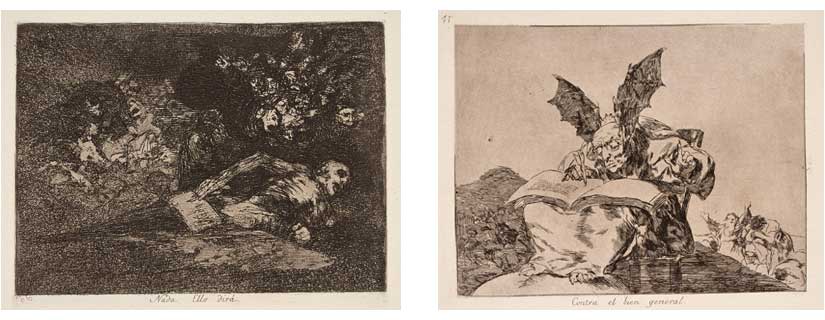 Francisco de Goya: Nothing. The Event Will Tell | Against the Common Good
Francisco de Goya: Nothing. The Event Will Tell | Against the Common Good
The technique used in most of these engravings is etching. In general they depict not popular heroes or military leaders but ordinary people set against indeterminate backgrounds. Their predominantly pyramidal composition, combined with contrasting black and white, makes the images particularly dramatic and draws the spectator's eyes to the main points of the scene. José Manuel Matilla explains that "this greatly reduces the distance between the spectator and the central figure. That proximity is not merely visual but extends to the emotions: spectators cannot help but feel moved at these prints".
The titles and texts that accompany the images are themselves well worth commenting on. As he did in the Caprices, Goya added laconic phrases, sometimes consisting of no more than a word, which served to summarise, reinforce and emphasise the ideas in the images. By contrast, most of the commemorative prints published during the Peninsular War and the years that followed were accompanied by long descriptive texts. The first print, Sad Forebodings of What is to Happen, is a case in point: it serves almost as a foreshadowing of the horrors and evils to be seen in the rest of the images. Goya's friend and mentor Juan Agustín Ceán Bermúdez, a major figure in the origins of the Banco de España Collection, also played a key role in the production and safeguarding of this series. Spanish Professor of History of Art Jesusa Vega states in her book Estudios. Desastres de la Guerra ["Studies. Disasters of War"], published by Planeta in 2008, that Goya gave him the plates to put them in order and engrave the titles. In fact Ceán Bermúdez held one of only two complete sets of these engravings that were ever printed during Goya's lifetime: the full series was not published until the 1860s.
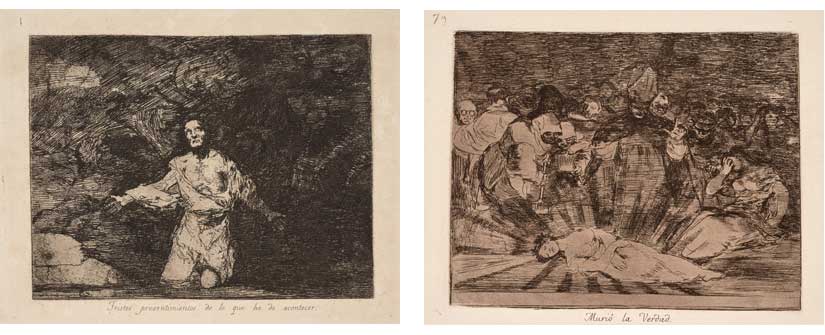 Francisco de Goya: Sad Forebodings of What is to Happen | Truth has Died
Francisco de Goya: Sad Forebodings of What is to Happen | Truth has Died
Like the rest of Goya's output, the set of prints of Disasters of War bear witness to how extraordinarily modern his outlook as an artist was. In his Itinerary Goya. A Contemporary Reflection on Fear and Death, which focuses on the three series of engravings that we hold in our Collection (the others being Bullfighting and the four Follies published by the magazine L’Art), Matilla states that he can be considered as "the first modern reference point for artists who not only work on commission but also create on a different level as prolifically as in their official work or even more so". He used his creativity not only to carry out bold experiments in form and concept but also to reflect with great lucidity on the ethical value of images and the role to be played by art in society.
